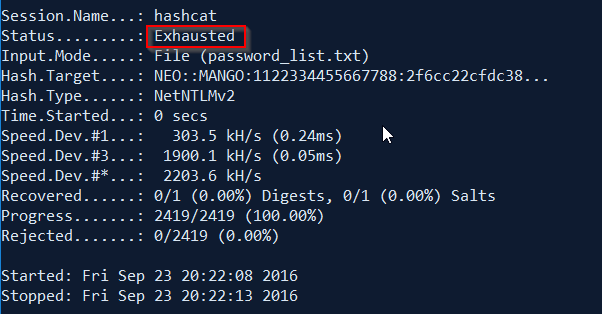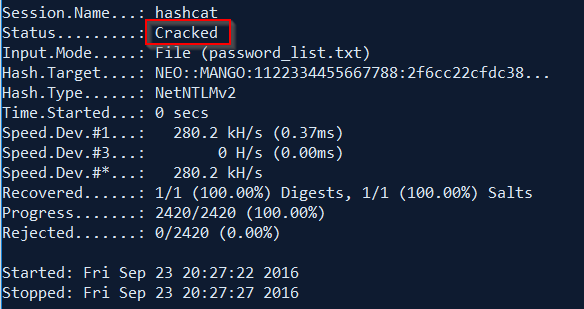Cracking NTLMv2 responses captured using responder

In the previous post, a Raspberry Pi Zero was modified to capture hashes (or rather NTLMv2 responses from the client).
Let’s see how hashcat can be used to crack these responses to obtain the user password. I will be using dictionary based cracking for this exercise on a Windows system.
Setup
Download the latest version of hashcat binaries from here - v3.10 at the time of writing.
Unzip the 7z file and open a command prompt at the unzipped location.
For convenience, I have created two directories in the hashcat folder:
hashes - to store the responses that need to be cracked
cracked - to store the cracked passwords
Captured responses
The client response captured by Responder was:
[HTTP] NTLMv2 Client : 192.168.154.131
[HTTP] NTLMv2 Username : MANGO\neo
[HTTP] NTLMv2 Hash : neo::MANGO:1122334455667788:2F6CC22CFDC387CFEEB2D325E8997564:0101000000000000C79708D95F14D2011D717D511A761654000000000200060053004D0042000100160053004D0042002D0054004F004F004C004B00490054000400120073006D0062002E006C006F00630061006C000300280073006500720076006500720032003000300033002E0073006D0062002E006C006F00630061006C000500120073006D0062002E006C006F00630061006C0008003000300000000000000000000000001000001047325384B3A000DD5138E15668CB4F44DA5471DAF7A327B5B4E3C19DC485120A001000000000000000000000000000000000000900120048005400540050002F0077007000610064000000000000000000
where,
MANGO is my domain name and neo is the user who was logged into the system.
I saved the response into a text file named hash.txt in the hashes folder created earlier.

Cracking using hashcat
The hashcat developers have done a wonderful job in simplifying the cracking process. All you need is a fast cracking machine and patience. :)
Since this is a dictionary based cracking, there are two scenarios here:
- Your password list does not contain the user password
- Your password list has the user password
I wanted to show both scenarios here, starting with the worst case - not having the password in the list.
For the sake of the the demo, I extracted a subset of the passwords from example.dict that comes with hashcat and saved it as password_list.txt in the hashcat folder. For the first run, the password_list.txt does not have the user password.
Open a command prompt at the extracted hashcat folder. For NTLMv2 cracking, the hashcat can be run as,
hashcat64.exe -m 5600 hashes\hash.txt password_list.txt -o cracked\cracked.txt
If you don’t specify -o switch, the password (if cracked) will be stored in hashcat.pot file in the hashcat folder.
If the password is not found, this is what you see once hashcat completes the cracking.
Status: Exhausted

For the next run, the case if I have the user password in my password list. I edited the password_list.txt and appended the user password (I created the user, remember :)).
Running the hashcat tool again,
hashcat64.exe -m 5600 hashes\hash.txt password_list.txt -o cracked\cracked.txt
Status: Cracked

To view the cracked password, see the cracked.txt file in the folder named cracked.

The success of cracking the password using this method solely depends on whether or not your password list is good enough.